
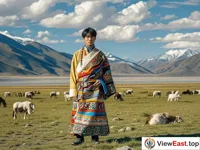
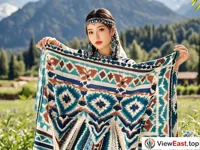
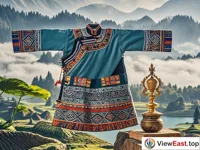

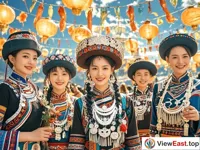
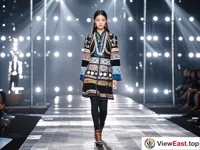
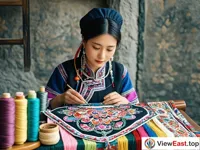
In the vast expanse of China, 56 ethnic groups coexist, each with its unique culture and traditional attire. These vibrant and diverse costumes are not only symbols of ethnic identity but also vital carriers of cultural heritage. This article will explore the traditional costumes of China's ethnic minorities from multiple dimensions, showcasing their rich and colorful life content.
I. Diversity of Attire
The costumes of China's ethnic minorities are varied and colorful. For example:
Miao's Silver Ornaments: Miao costumes are primarily adorned with silver decorations, which are exquisitely crafted and come in diverse shapes, reflecting the Miao people's pursuit of beauty.
Tibetan's Chuba: Tibetan Chuba is vibrant in color and rich in patterns, reflecting the Tibetan people's reverence for nature and religion.
Uyghur's Adras: The Uyghur Adras silk is famous for its unique dyeing techniques and patterns, symbolizing Uyghur culture.
II. Cultural Significance of Attire
Each type of attire holds its unique cultural significance:
Totem Worship: Many ethnic costumes feature totem patterns, representing the beliefs and worship of the ethnic group.
Social Status: The material and decoration of the attire often reflect the wearer's social status and wealth.
Festival Celebrations: During festivals, people wear their most splendid attire to show celebration and respect.
III. Craftsmanship of Attire
The craftsmanship of ethnic minority attire is exquisite, reflecting the wisdom and creativity of the ethnic groups:
Embroidery: Embroidery is an essential part of many ethnic costumes, with fine workmanship and vivid patterns.
Weaving: Weaving skills are widespread among ethnic minorities, such as the Zhuang brocade and the Yi fire grass cloth.
Dyeing: The dyeing techniques of ethnic minorities are unique, such as the Miao indigo dyeing and the Bai tie-dyeing.
IV. Modern Influence
With the development of modern society, the traditional attire of ethnic minorities is also gradually integrating into modern life:
Fashion Integration: Many designers incorporate elements of ethnic minority attire into modern fashion design, making it more diverse.
Cultural Protection: Governments and non-governmental organizations are working hard to protect and pass on the attire culture of ethnic minorities.
Tourism Promotion: The attire of ethnic minorities has also become an important element to attract tourists, promoting the development of local tourism.
V. Conclusion
The traditional attire of China's ethnic minorities is a treasure of Chinese culture. They not only showcase the life customs and aesthetic tastes of various ethnic groups but also embody the spirit of the nation.